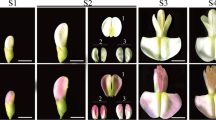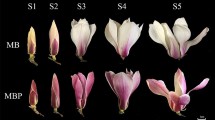Abstract
Malus hupehensis (Pamp.) Rehder is an indigenous wild crabapple tree from China that has received increased attention, due to its significant ornamental and economical values. The flowers change from red to white during development, a phenomenon that is prevalent within Malus genus. However, there are no reports on the phytochemical aspects of M. hupehensis flower. Here, we investigated the mechanism of color fading through biochemical and molecular analysis of M. hupehensis petals during development. Sixteen flavonoids were detected, and cyanidin-3-galactoside was the major anthocyanin in petals. The levels of most compounds initially increased and then decreased during flower development. The changing profile of total anthocyanins was consistent with the changes in floral color. Analysis of anthocyanin biosynthesis-related genes showed that the expression levels of PAL, CHS, CHI, DFR, FLS, ANS, UFGT, MYB10 and MYB12 were significantly higher at early stages than at later stages, similarly to the change in cyanidin-3-galactoside contents. MYB10 and MYB12 significantly positively correlated with CHS, CHI and DFR. There was a particularly strong positive correlation between MYB10 and ANS, and MYB12 was strongly positively correlated with LAR. Thus, MYB10 appeared to regulate mainly anthocyanin biosynthesis, and MYB12 could influence the expression of multiple structural genes in both the anthocyanin and flavanol pathways. By contrast, MYB6, bHLH33 and WD40 were significantly and positively correlated with one another but negatively correlated with the levels of many compounds and most structural genes, indicating that these three transcription factors could regulate together anthocyanin biosynthesis. Our results revealed the information about the temporal and spatial regulation of anthocyanin biosynthesis in M. hupehensis and provide the diverse flower color intensities and patterning in Chinese crabapple.





Similar content being viewed by others
References
An XH, Tian Y, Chen KQ, Wang XF, Hao YJ (2012) The apple WD40 protein MDTTG1 interacts with bHLH but not MYB proteins to regulate anthocyanin accumulation. J Plant Physiol 169:710–717. https://doi.org/10.1016/j.jplph.2012.01.015
Casimiro-Soriguer I, Eduardo N, Buide ML, del Valle JC, Whittall JB (2016) Transcriptome and biochemical analysis of a flower color polymorphism in Silene littorea (Caryophyllaceae). Front Plant Sci. https://doi.org/10.3389/fpls.2016.00204
Espley R, Hellens R, Putterill J, Stevenson D, Kutty-Amma S, Allan A (2007) Red colouration in apple fruit is due to the activity of the MYB transcription factor, MdMYB10. Plant J 49:414–427. https://doi.org/10.1111/j.1365-313x.2006.02964.x
Espley RV, Bovy A, Bava C et al (2013) Analysis of genetically modified red-fleshed apples reveals effects on growth and consumer attributes. Plant Biotechnol J 11:408–419. https://doi.org/10.1111/pbi.12017
Gao J, Shen X, Zhang Z, Peng RH, Xiong A, Xu J, Yao Q (2011) The MYB transcription factor MdMYB6 suppresses anthocyanin biosynthesis in transgenic Arabidopsis. Plant Cell Tissue Organ Cult 106:235–242. https://doi.org/10.1007/s11240-010-9912-9914
Hu Q, Chen Y, Jiao Q, Khan A, Shan J, Cao G, Li F, Zhang C, Lou H (2017) Polyphenolic compounds from Malus hupehensis and their free radical scavenging effects. Nat Prod Res 32:1–7. https://doi.org/10.1080/14786419.2017.1367784
Iwashina T (2015) Contribution to flower colors of flavonoids including anthocyanins: a review. Nat Prod Commun 10:529–544. https://doi.org/10.1177/1934578x1501000335
Jiang R, Tian J, Song T, Zhang J, Yao Y (2014) The Malus crabapple transcription factor McMYB10 regulates anthocyanin biosynthesis during petal coloration. Sci Hortic 166:42–49. https://doi.org/10.1016/j.scienta.2013.12.002
Li HH, Flachowsky H, Fischer TC, Hanke MV, Forkmann G, Treutter D, Schwab W, Hovmann T, Szankowski I (2007) Maize lc transcription factor enhances biosynthesis of anthocyanins, distinct proanthocyanidins and phenylpropanoids in apple (Malus domestica Borkh.). Planta 226:1243–1254. https://doi.org/10.2307/23389811
Li Z, Zhao M, Jin J, Zhao L, Xu Z (2018) Anthocyanins and their biosynthetic genes in three novel-colored Rosa rugosa cultivars and their parents. Plant Physiol Biochem 129:421–428. https://doi.org/10.1016/j.plaphy.2018.06.028
Liu J, Osbourn A, Ma P (2015) MYB transcription factors as regulators of phenylpropanoid metabolism in plants. Mol Plant 8:689–708. https://doi.org/10.1016/j.scienta.2013.12.002
Liu Y, Tikunov Y, Schouten RE, Marcelis LFM, Visser RGF, Bovy A (2018) Anthocyanin biosynthesis and degradation mechanisms in Solanaceous vegetables: a review. Front Chem. https://doi.org/10.3389/fchem.2018.00052
Peng T, Moriguchi T (2013) The molecular network regulating the coloration in apple. Sci Hortic 163:1–9. https://doi.org/10.1016/j.scienta.2013.06.005
Ran K, Yang H, Sun X, Li Q, Jiang Q, Zhang W, Shen W (2014) Isolation, characterization, and structure analysis of a vacuolar processing enzyme gene (MhVPEγ) from Malus hupehensis (Pamp) Rehd. Appl Biochem Biotechnol 173:579–595. https://doi.org/10.1007/s12010-014-0867-5
Rehman R, You Y, Yang C, Khan AR, Li P, Ma F (2017) Characterization of phenolic compounds and active anthocyanin degradation in crabapple (Malus orientalis) flowers. Hortic Environ Biotechnol 58:324–333. https://doi.org/10.1007/s13580-018-0001-7
Starkevič P, Paukštytė J, Kazanavičiūtė V, Denkovskienė E, Stanys V, Bendokas V, Šikšnianas T, Ražanskienė A (2015) Expression and anthocyanin biosynthesis modulating potential of sweet cherry (Prunus avium L.) MYB10 and bHLH genes. PLoS ONE. https://doi.org/10.1371/journal.pone.0126991
Tian J, Zhang J, Han Z, Song T, Li J, Wang Y, Yao Y (2017) McMYB12 transcription factors co-regulate proanthocyanidin and anthocyanin biosynthesis in Malus crabapple. Sci Rep. https://doi.org/10.1038/srep43715
Verweij W, Spelt C, Di Sansebastiano GP, Vermeer J, Reale L, Ferranti F, Koes R, Quattrocchio F (2008) An H+ P-ATPase on the tonoplast determines vacuolar pH and flower colour. Nat Cell Biol 10:1456–1462. https://doi.org/10.1038/ncb1805
Wang S, Zhu X, Wang X, Shen T, Xiang F, Lou H (2013) Flavonoids from Malus hupehensis and their cardioprotective effects against doxorubicin-induced toxicity in H9c2 cells. Phytochemistry 87:119–125. https://doi.org/10.1016/j.phytochem.2012.11.020
Wang N, Xu H, Jiang S, Zhang Z, Lu N, Qiu H, Qu C, Wang Y, Wu S, Chen X (2017) MYB12 and MYB22 play essential roles in proanthocyanidin and flavonol synthesis in red-fleshed apple (Malus sieversii f. niedzwetzkyana). Plant J 90:276–292. https://doi.org/10.1111/tpj.13487
Wolfe K, Wu XZ, Rui HL (2003) Antioxidant activity of apple peels. J Agric Food Chem 51:609–614. https://doi.org/10.1021/jf020782a
Xu H, Wang N, Liu J, Qu C, Wang Y, Jiang S, Lu N, Wang D, Zhang Z, Chen X (2017) The molecular mechanism underlying anthocyanin metabolism in apple using the MdMYB16 and MdbHLH33 genes. Plant Mol Biol 94:149–165. https://doi.org/10.1007/s11103-017-0601-0
Yue Y, Liu J, Shi T, Chen M, Li Y, Du J, Jiang H, Yang X, Hu H, Wang L (2019) Integrating transcriptomic and GC-MS metabolomic analysis to characterize color and aroma formation during tepal development in Lycoris longituba. Plants. https://doi.org/10.3390/plants8030053
Zhang J, Liu Y, Bu Y, Zhang X, Yao Y (2017) Factor analysis of MYB gene expression and flavonoid affecting petal color in three crabapple cultivars. Front Plant Sci. https://doi.org/10.3389/fpls.2017.00137
Zhao D, Tao J (2015) Recent advances on the development and regulation of flower color in ornamental plants. Front Plant Sci 6:261. https://doi.org/10.3389/fpls.2015.00261
Zhao L, Gao L, Wang H, Chen X, Wang Y, Yang H, Wei C, Wan X, Xia T (2013) The R2R3-MYB, bHLH, WD40, and related transcription factors in flavonoid biosynthesis. Funct Integr Genom 13:75–98. https://doi.org/10.1007/s10142-012-0301-4
Acknowledgements
This work was supported by the National Natural Science Foundation of China [31570697].
Author information
Authors and Affiliations
Contributions
The experiments were conceived and designed by Houhua Li. The experiments were carried out by Meiling Han, Chen Yang, Jiaxin Meng and Ting Shen. The data were analyzed by Meiling Han and Chen Yang. Meiling Han, Jing Zhou and Jiabin Zhu drafted the manuscript and gathered figures. Jiaxin Meng, Zhuanxia Xin, Ting Shen and Jiabin Zhu participated in the design of experiments and edited the manuscript. All authors read, edited and approved the manuscript.
Corresponding author
Additional information
Publisher's Note
Springer Nature remains neutral with regard to jurisdictional claims in published maps and institutional affiliations.
Electronic supplementary material
Below is the link to the electronic supplementary material.
Rights and permissions
About this article
Cite this article
Han, M., Yang, C., Zhou, J. et al. Analysis of flavonoids and anthocyanin biosynthesis-related genes expression reveals the mechanism of petal color fading of Malus hupehensis (Rosaceae). Braz. J. Bot 43, 81–89 (2020). https://doi.org/10.1007/s40415-020-00590-y
Received:
Revised:
Accepted:
Published:
Issue Date:
DOI: https://doi.org/10.1007/s40415-020-00590-y




